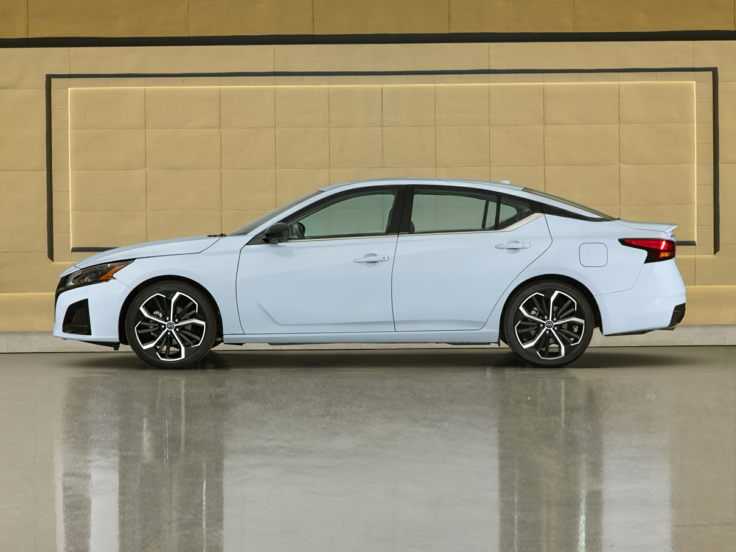Nissan ALTIMA 2023 Hill start assist system and Cold weather driving
The 2023 Nissan Altima is designed to perform admirably in harsh environments and inclement weather, offering a flexible and cozy driving experience all year long. It easily climbs hills and keeps traction on slippery roads thanks to features like optional all-wheel drive and hill-start assist. The Altima’s features, which include a remote engine start, heated seats, steering wheel, and enhanced insulation for a quiet cabin, make it impervious to cold weather. In addition, the Altima’s optional premium sound systems and smartphone connectivity improve the audio experience, making every trip not just secure and comfortable but also enjoyable for fans of music and entertainment.
2023 Nissan Altima Specs, Price, Features and Mileage (Brochure)
HILL START ASSIST SYSTEM
WARNING
- Never rely solely on the hill start assist system to prevent the vehicle from moving backward on a hill. Always drive carefully and attentively. Depress the brake pedal when the vehicle is stopped on a steep hill. Be especially careful when stopped on a hill on frozen or muddy roads. Failure to prevent the vehicle from rolling backward may result in a loss of control of the vehicle and possible serious injury or death. The hill start assist system is not designed to hold the vehicle at a standstill on a hill. Depress the brake pedal when the vehicle is stopped on a steep hill. Failure to do so may cause the vehicle to roll backward and may result in a collision or serious personal injury. The hill start assist system may not prevent the vehicle from rolling backward on a hill under all loads or road conditions. Always be prepared to depress the brake pedal to prevent the vehicle from rolling backward. Failure to do so may result in a collision or serious personal injury. When the vehicle is stopped on a hill, the hill start assist system automatically keeps the brakes applied to help prevent the vehicle from rolling backward in the time it takes the driver to release the brake pedal and apply the accelerator.
The hill start assist system will operate automatically under the following conditions:
The transmission is shifted to a forward or reverse gear. The vehicle is stopped completely on a hill by applying the brake. The maximum holding time is 2 seconds. After 2 seconds the vehicle will begin to roll back and the hill start assist system will stop operating completely. The hill start assist system will not operate when the shift lever is placed in the N (Neutral) or P (Park) position or on a flat and level road.
REAR SONAR SYSTEM (RSS)
The RSS sounds a tone to inform the driver of obstacles near the bumper. When the “DISPLAY” key is on, the sonar view will automatically appear on the touch-screen display. An additional view of the sonar status will appear in the vehicle information display for reference.
WARNING
- The RSS is a convenience but it is not a substitute for proper parking.
- The driver is always responsible for safety during parking and other maneuvers. Always look around and check that it is safe to do so before parking.
- Read and understand the limitations of the RSS as contained in this section. The colors of the corner sonar indicator and the distance guidelines in the rearview indicate different distances to the object.
- Inclement weather or ultrasonic sources such as an automatic car wash, a truck’s compressed-air brakes or a pneumatic drill may affect the function of the system; this may include reduced performance or a false activation.
- This function is designed as an aid to the driver in detecting large stationary objects to help avoid damaging the vehicle.
- The system is not designed to prevent contact with small or moving objects. Always move slowly. The system will not detect small objects below the bumper, and may not detect objects close to the bumper or on the ground.
- The system may not detect the following objects: fluffy objects such as snow, cloth, cotton, glass, wool, etc.; thin objects such as rope, wire chain, etc.; or wedge-shaped objects.
- If your vehicle sustains damage to the bumper fascia, leaving it misaligned or bent, the sensing zone may be altered causing inaccurate measurement of obstacles or false alarms.
CAUTION
Excessive noise (such as audio system volume or an open vehicle window) will interfere with the tone and it may not be heard. Keep the sonar sensors (located on the bumper fascia) free from snow, ice, and large accumulations of dirt. Do not clean the sensors with sharp objects. If the sensors are covered, the accuracy of the sonar function will be diminished.
SYSTEM OPERATION
The system informs with a visual and audible alert of rear obstacles when the shift lever is in the R (Reverse) position. The system is deactivated at speeds above 6 mph (10 km/h). It is reactivated at lower speeds. The intermittent tone will stop after 3 seconds when an obstacle is detected by only the corner sensor and the distance does not change. The tone will stop when the obstacle gets away from the vehicle. When the object is detected, the indicator (green) appears and blinks and the tone sounds intermittent. When the vehicle moves closer to the object, the color of the indicator turns yellow, and the rate of blinking increases. When the vehicle is very close to the object, the indicator stops blinking and turns red, and the tone sounds continuous.
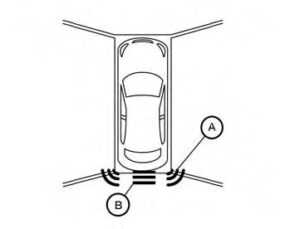
When the corner of the vehicle moves closer to an object, the corner sonar indicator OA appears. When the center of the vehicle moves close to an object, the center sonar indicator OB appears.
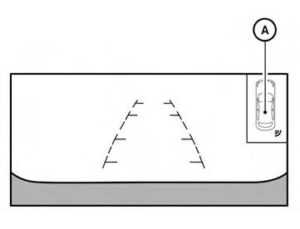
The system indicators OA will appear when the vehicle moves closer to an object.
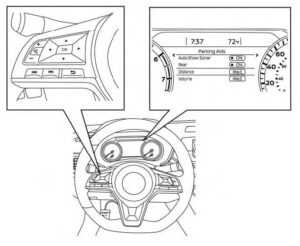
HOW TO ENABLE/DISABLE THE SONAR SYSTEM
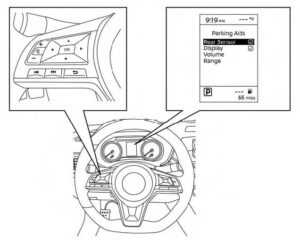
The system is automatically activated when the ignition is in the ON position and the shift lever is in the R (Reverse) position.
Perform the following steps to enable or disable the sonar system:
For vehicles with 7-inch (18 cm) display.
- Press the button until “Settings” displays in the vehicle information display. Use the button to select “Driver Assistance.” Then press the OK button.
- Select “Parking Aids” and press the OK button.
- Select “Rear” and press the OK button to turn the system on or off.
- Select “Auto Show Sonar” to display the parking sensor in the vehicle information display when the sonar system activates.
- Select “Distance” to change the sonar system distance to “Long”, “Medium” or “Short”.
- Select “Volume” to change the sonar system volume to “High”, “Medium” or “Low”.
For vehicles with 5-inch (13 cm) display.
- Press the button until “Settings” displays in the vehicle information display. Use the button to select “Driver Assistance.” Then press the OK button.
- Select “Parking Aids” and press the OK button.
- Select “Rear Sensor” and press the OK button to turn the system on or off.
- Select “Display” to display the parking sensor in the vehicle information display when the sonar system activates.
- Select “Volume” to change the sonar system volume to “High”, “Medium” or “Low”.
- Select “Range” to change the sonar system distance to “Far,” “Mid.” or “Near.”
SONAR LIMITATIONS
Listed below are the system limitations for the sonar system. Failure to operate the vehicle in accordance with these system limitations could result in serious injury or death.
- The system is deactivated at speeds above 6 mph (10 km/h). It is reactivated at lower speeds.
- Inclement weather or ultrasonic sources such as an automatic car wash, a truck’s compressed-air brakes or a pneumatic drill may affect the function of the system; this may include reduced performance or a false activation.
- The system is not designed to prevent contact with small or moving objects. Always move slowly. The system will not detect small objects below the bumper or on the ground.
- Inclement weather or ultrasonic sources such as an automatic car wash, a truck’s compressed-air brakes or a pneumatic drill may affect the function of the system; this may include reduced performance or a false activation.
- The system is not designed to prevent contact with small or moving objects. Always move slowly. The system will not detect small objects below the bumper or on the ground.
- Do not attach stickers (including transparent material), install accessories, or apply anything blocking the sensors. These conditions may reduce the ability of the system.
SYSTEM TEMPORARILY UNAVAILABLE
When sonar blockage is detected, the system will be deactivated automatically. The system is not available until the conditions no longer exist. The sonar sensors may be blocked by temporary ambient conditions such as splashing water, mist or fog. The blocked condition may also be caused by objects such as ice, frost or dirt obstructing the sonar sensors.
Action to take:
When the above conditions no longer exist, the system will resume automatically.

SYSTEM MAINTENANCE
The sonar sensors 1O are located on the rear bumper. Always keep the area near the sonar sensors clean.
The sonar sensors may be blocked by temporary ambient conditions such as splashing water, mist, or fog.
The blocked condition may also be caused by objects such as ice, frost, or dirt obstructing the sonar sensors. Check for and remove objects obstructing the area around the sonar sensors.
Do not attach stickers (including transparent material), install accessories, or apply additional paint near the sonar sensors.
Do not strike or damage the area around the sonar sensors. It is recommended that you visit a NISSAN dealer if the area around the sonar sensors is damaged due to a collision.
COLD WEATHER DRIVING
FREEING A FROZEN DOOR LOCK
To prevent a door lock from freezing, apply a deicer through the keyhole. If the lock becomes frozen, heat the key before inserting it into the keyhole or use the remote keyless entry function on the Intelligent Key.
ANTIFREEZE
In the winter when it is anticipated that the temperature will drop below 32°F (0°C), check the antifreeze to ensure proper winter protection.
BATTERY
If the battery is not fully charged during extremely cold weather conditions, the battery fluid may freeze and damage the battery.
DRAINING OF COOLANT WATER
If the vehicle is to be left outside without antifreeze, drain the cooling system, including the engine block. Refill before operating the vehicle.
TIRE EQUIPMENT
- SUMMER tires have a tread designed to provide superior performance on dry pavement. However, the performance of these tires will be substantially reduced in snowy and icy conditions. If you operate your vehicle on snowy or icy roads, NISSAN recommends the use of MUD & SNOW or ALL SEASON TIRES on all four wheels. It is recommended that you visit a NISSAN dealer for the tire type, size, speed rating, and availability information.
- For additional traction on icy roads, studded tires may be used. However, some U.S. states and Canadian provinces prohibit their use. Check local, state, and provincial laws before installing studded tires.
Skid and traction capabilities of studded snow tires on wet or dry surfaces may be poorer than that of non-studded snow tires. - Tire chains may be used.
SPECIAL WINTER EQUIPMENT
It is recommended that the following items be carried in the vehicle during winter:
- A scraper and stiff-bristled brush to remove ice and snow from the windows and wiper blades.
- A sturdy, flat board to be placed under the jack to give it firm support.
- A shovel to dig the vehicle out of snowdrifts.
- Extra washer fluid to refill the windshield washer fluid reservoir.
DRIVING ON SNOW OR ICE
WARNING
- Wet ice (32°F, 0°C, and freezing rain), and very cold snow or ice can be slick and very hard to drive on. The vehicle will have much less traction or “grip” un-der these conditions. Try to avoid driving on wet ice until the road is salted or sanded.
- Whatever the condition, drive with caution. Accelerate and slow down with care. If accelerating or down-shifting too fast, the drive wheels will lose even more traction.
- Allow more stopping distance under these conditions. Braking should be started sooner than on dry pavement.
- Allow greater following distances on slippery roads.
- Watch for slippery spots (glare ice). These may appear on an otherwise clear road in shaded areas. If a patch of ice is seen ahead, brake before reaching it. Try not to brake while on the ice, and avoid any sudden steering maneuvers.
- Do not use cruise control on slippery roads.
- Snow can trap dangerous exhaust gases under your vehicle. Keep snow clear of the exhaust pipe and from around your vehicle.
ENGINE BLOCK HEATER (if so equipped)
Engine block heaters are used to assist with cold temperature starting. The engine block heater should be used when the outside temperature is 20°F (-7°C) or lower.
WARNING
Do not use your engine block heater with an ungrounded electrical system or a 2-pronged adapter. You can be seriously injured by an electrical shock if you use an ungrounded connection. Disconnect and properly store the engine block heater cord before starting the engine. Damage to the cord could result in an electrical shock and can cause serious injury. Use a heavy-duty 3-wire, 3-pronged extension cord rated for at least 10 A. Plug the extension cord into a Ground Fault Interrupt (GFI) protected, grounded 110-VAC outlet. Failure to use the proper extension cord or a grounded outlet can result in a fire or electrical shock and cause serious personal injury.
To use the engine block heater:
- Turn the engine off.
- Open the hood and unwrap the engine block heater cord.
- Plug the engine block heater cord into a grounded 3-wire, 3-pronged extension cord.
- Plug the extension cord into a Ground Fault Interrupt (GFI) protected, grounded 110- volt AC (VAC) outlet.
- The engine block heater must be plugged in for at least 2–4 hours, depending on outside temperatures, to properly warm the engine coolant. Use an appropriate timer to turn the engine block heater on.
- Before starting the engine, unplug and properly store the cord to keep it away from moving parts.
Nissan ALTIMA 2023 “Active noise cancellation/Active sound enhancement” 
Front Microphone
ACTIVE NOISE CANCELLATION
This system uses microphones 1O located inside the vehicle to detect engine boom- ing noise. The system then automatically generates a noise canceling sound through the speakers and woofer (if so equipped) to reduce engine booming noise.
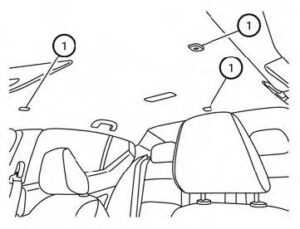
Rear Microphones
NOTE:
To operate the active noise cancellation system properly:
- Do not cover the speakers or woofer (if so equipped).
- Do not cover the microphones.
- Do not change or modify speakers including the woofer (if so equipped) and any audio-related components such as the amplifier.
- Do not make any modifications including sound deadening or modifications around the microphones or speakers.
ACTIVE SOUND ENHANCEMENT
Active sound enhancement enhances existing engine sounds according to the engine speed and driving modes through the speakers and woofer (if so equipped).
Useful Link
View Full User Guide: Nissan ALTIMA 2023 User Guide
Download Manuals: https://www.nissanusa.com/owners/ownership/manuals-guides.html
2023 Nissan Altima Specs, Price, Features and Mileage (Brochure)

